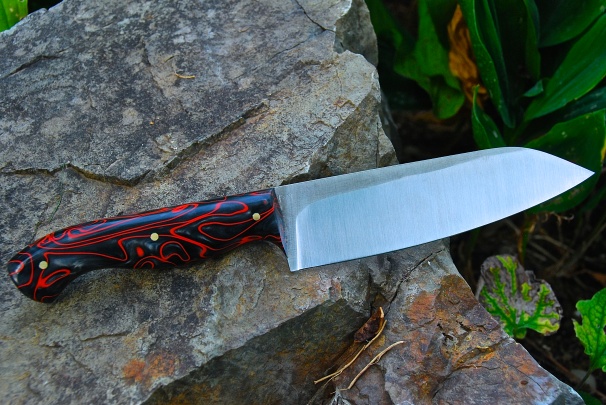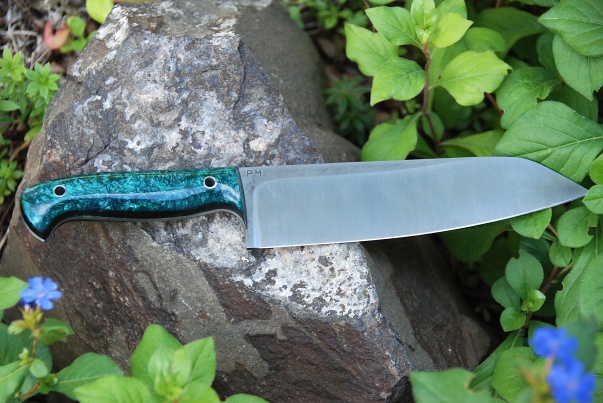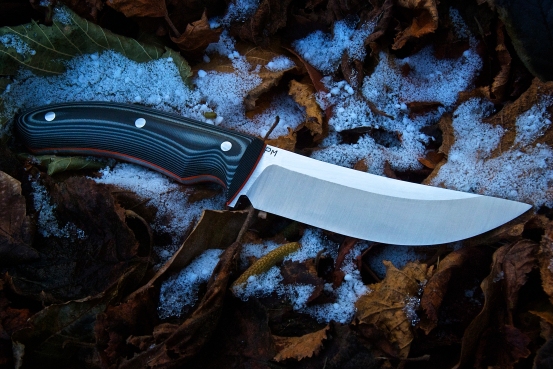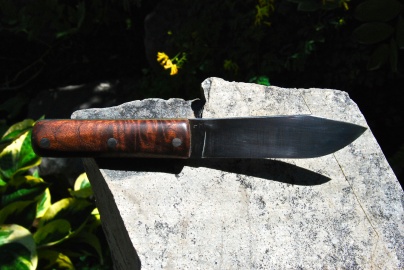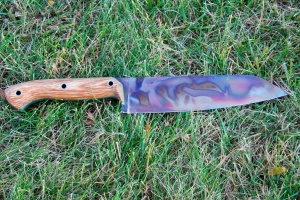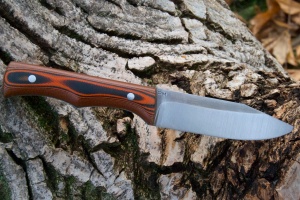I receive lots of questions on kitchen knives so I though I would compile all the relevant information I know into one spot. I will share my thoughts/ramblings on kitchen knives. These points can be applied to all knives but I will write specifically toward kitchen knives. Obviously, the object to achieve in a kitchen knife is a knife that the user wants to use and continues to work well over time.
1. Shape There are 2 main shape full sized kitchen knives and infinite reiterations of the 2 shapes. The shapes are santoku and chef. If a 8-10 inch blade is too big and heavy for you, consider a small santoku or chef knife (pictured at the bottom.) There are also fillet knives, paring knives, cleavers, and countless specialty shapes that I won’t discuss. There are unique advantages to both shapes and it comes down to person preference as to which is best for you. The advantage of the santoku is that the cutting edge is nearly flat and chops well with just enough rocker to mince nicely but not so much slicing is hindered. The chef knife is the generic kitchen knife and is typically a little longer than a santoku. It is considered the essential kitchen knife and does everything well except the slicing is impaired due to having more belly or rocker. Both are very functional are really not very different. It all comes down to how you use your knives and what are comfortable with.  Chef on top, santoku on bottom.
Chef on top, santoku on bottom.
2. The Grind
There are three basic types of grinds. Hollow, flat, and convex (picture bellow.) For kitchen knives it is ideal to have a knife that extremely lean/thin behind the edge. This means that the thickness of the steel behind the secondary bevel (edge) is as small as possible. Obviously, as that thickness decreases, the edge become more fragile and must be used more gently due to there being less material. I prefer flat grinds for many reasons. First, they are a consistent angle through out the entire bevel. This means the difficulty of cutting doesn’t get more difficult (as with hollow) or easier (as with convex, but starts harder.) Also, flat grinds are easier to grind than other’s and look better than convex. Edge angle is another important issue to consider. A steeper angle, such as 35 degrees, will be stronger. Whereas a 15 or 12 degree edge will be extremely easy to start a cut (like tomato skins) but dull or chip easier. For myself I prefer a very lean grind and shallow angle on the edge, but for customers I do a slightly thicker edge and steeper edge angle to improve strength since I don’t know how the knife will be treated.
 unground, convex, flat, hollow
unground, convex, flat, hollow
3. Blade Steel
This is a big dilemma in the knife world and an important choice for any knife. There are two classifications of steel. Stainless and non-stainless. Stainless is best right? Wrong. Well, maybe. It depends on how the knife is treated and your skill at sharpening. Non-stainless/carbon steel (o1 or a2 for me) must have less than 12% chromium but usually have less than 5%. This means the knife will rust or stain very easily however, advantage of not having much chromium is that the knife can get sharper, stay sharper and sharpen easier in most cases. This of course varies greatly steel to steel but in general that is the case. Stainless (154cm or s30v for me) has the advantage of being very resistant to rust and corrosion but suffers when it comes to resharpening. The 2 stainless steels I use will get as sharp and hold their edge as well or better than carbon steels. The “tweener” steel is D2 tool steel. It features 11% chromium which is far more than the 1% in o1 yet less than the 14% in 154cm and s30v. It is technically a carbon steel but acts more like a stainless than carbon in my opinion. Some say it gets the best of both worlds and others say it gets the worst of both worlds but every steel is a compromise in some way and d2 is just another example of balancing the compromises. Steel choice comes down to how you will use your knife but a lot of customers order and enjoy d2.
4. Handle Material
There are many, many different materials that I use for handles. Most factory knives have a black plastic that is simple and functional. However, in my knives I prefer to use nicer, prettier, grippier materials. I have used woods but I like to avoid that because they absorb water, swell, and are not durable in a wet environment. One common synthetic is g10. It is fiberglass layered into a block that is then shaped into a handle. It looks and feels nice but lacks much grip. The grippiest material is micarta. It is like g10 but uses natural fiber sheets (canvas, linen or paper) instead of fiberglass. I like micarta because it is very grippy when wet because of the threads in the handle are exposed, but it does not look as clean as g10 and it can absorb certain juices and other liquids in the kitchen. Next is a new material called kirinite. I like this material for its stunning colors and patterns. It is made of a dense plastic that feels rubbery and comes in many patterns. It can be buffed to a very shiny finish and is still fairly grippy. The downside to kirinite is it is very expensive (about $25 extra for a knife.) Another option I use often is called dymonwood. It is thin sheets of wood that are saturated with resin. This creates a 100% stable, abuse proof handle that looks like it is made from natural wood. I buff this material to finish and this creates a shiny finish that is about as grippy as kirinite. Again, what ever strikes your fancy and you like the feel of is the right material for you. 
Black linen micarta, Chef knife
Dymondwood cocobolo, Santoku knife
Red lava Kirinite, Small Santoku knife
Black and grey G10
Metal flake green Kirinite, Santoku knife
Dymondwood, Small Santoku knife
Red linen Micarta, small Chef knife
 Close up of the metal flake kirinite
Close up of the metal flake kirinite
As you can tell there, are many choices to make when considering a custom (or factory) kitchen knife. I encourage you to keep these points in mind if your are interested in a commission. Hope you enjoyed this post! Thanks for reading. https://www.facebook.com/PorterMcMichaelKnives

